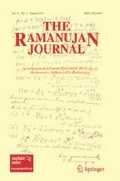Abstract
In 2011, Nathanson proposed several questions on minimal complements in a group or a semigroup. The notion of minimal complements and being a minimal complement leads to the notion of co-minimal pairs which was considered in a prior work of the authors. In this article, we study which type of subsets in the integers and free abelian groups of higher rank can be a part of a co-minimal pair. We show that a majority of lacunary sequences have this property. From the conditions established, one can show that any infinite subset of any finitely generated abelian group has uncountably many subsets which is a part of a co-minimal pair. Further, the uncountable collection of sets can be chosen so that they satisfy certain algebraic properties.
Similar content being viewed by others
References
Alon, N., Kravitz, N., Larson, M.: Inverse problems for minimal complements and maximal supplements. J. Number Theory 223, 307–324 (2021)
Burcroff, A., Luntzlara, N.: Sets arising as minimal additive complements in the integers. Preprint arxiv:2006.12481 (2020)
Biswas, A., Saha, J.P.: On minimal complements in groups. Ramanujan J. 3, 4 (2020). https://doi.org/10.1007/s11139-020-00309-3
Biswas, A., Saha, J.P.: Infinite co-minimal pairs in the integers and integral lattices, Combinatorial and additive number theory IV. In: Springer Proceedings of Mathematics Statistics, vol. 347. Springer, Berlin (2021)
Biswas, A., Saha, J.P.: On additive co-minimal pairs. J. Number Theory 223, 350–370 (2021)
Erdős, P.: Some results on additive number theory. Proc. Am. Math. Soc. 5, 847–853 (1954)
Erdős, P.: Some unsolved problems. Michigan Math. J. 4, 291–300 (1957)
Lorentz, G.G.: On a problem of additive number theory. Proc. Am. Math. Soc. 5, 838–841 (1954)
Melvyn, B.: Problems in additive number theory, IV: Nets in groups and shortest length \(g\)-adic representations. Int. J. Number Theory 7(8), 1999–2017 (2011)
Newman, D.J.: Complements of finite sets of integers. Michigan Math. J. 14, 481–486 (1967)
Ruzsa, I.Z.: Additive completion of lacunary sequences, Combinatorica 21(2) (2001), 279–291, Paul Erdős and his mathematics (Budapest, 1999). MR 1832452
Weinstein, G.: Minimal complementary sets. Trans. Am. Math. Soc. 212, 131–137 (1975)
Acknowledgements
The authors would like to thank the anonymous reviewer. The first author would like to thank the Department of Mathematics at the Technion where a part of the work was carried out.
Author information
Authors and Affiliations
Corresponding author
Additional information
Publisher's Note
Springer Nature remains neutral with regard to jurisdictional claims in published maps and institutional affiliations.
The work of the first author was supported by the ISF Grant No. 662/15. The second author was supported by the Initiation Grant from the Indian Institute of Science Education and Research Bhopal, and the INSPRE Faculty Award IFA18-MA123 from the Department of Science and Technology, Government of India.
Rights and permissions
About this article
Cite this article
Biswas, A., Saha, J.P. Infinite co-minimal pairs involving lacunary sequences and generalisations to higher dimensions. Ramanujan J 57, 1445–1462 (2022). https://doi.org/10.1007/s11139-021-00442-7
Received:
Accepted:
Published:
Issue Date:
DOI: https://doi.org/10.1007/s11139-021-00442-7


